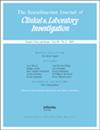Rest reduces venous lactate levels significantly in patients in outpatient clinic.
IF 1.3
4区 医学
Q4 MEDICINE, RESEARCH & EXPERIMENTAL
Scandinavian Journal of Clinical & Laboratory Investigation
Pub Date : 2023-09-01
Epub Date: 2023-06-24
DOI:10.1080/00365513.2023.2225224
引用次数: 0
Abstract
Abstract Lactate is produced in the human body during physical activity and elimination takes time with a half-life of approximately 18 min. We, therefore, investigated the potential impact of resting time (RT) duration on lactate concentration in our outpatient venipuncture clinic for all lactate requests during a 4½-year period. All samples drawn for venous lactate analysis during a 4½-year period in our hospital outpatient venipuncture clinics were included in this study. RT was reported electronically at each visit. Results from a total of 831 samples were obtained for further analysis. We found varying lactate concentrations across resting time <15min (median 1.6 mmol/L, IQR[1.2–2.1] mmol/L), between <15 min and >30 min (median 1.4 mmol/L, IQR[1.0–1.9] mmol/L) and for >30 min (median 1.3 mmol/L, IQR[1.0–1.7] mmol/L). There was a significant difference between <15 min versus 15–30 min (p = 0.015), which gives a 17.7% higher lactate from 15–30 min to <15 min. There was a significant 28.3% increase in mean lactate concentration from >30min to <15min (p < 0.0001) when corrected for age. We found that lactate concentration was dependent on RT in the outpatient clinic. The difference was clinically significant. Based on the results of this study, we, therefore, conclude that a 15 min waiting time before venipuncture for lactate sampling in an outpatient clinic is of clinical importance.休息可显著降低门诊患者的静脉乳酸水平。
乳酸是人体在体育活动中产生的,消除需要时间,半衰期约为18 min。因此,我们研究了在4年半的时间内,在我们的门诊静脉穿刺诊所,所有乳酸请求的休息时间(RT)持续时间对乳酸浓度的潜在影响。在我们医院门诊静脉穿刺诊所4年半的时间里,所有用于静脉乳酸分析的样本都包括在本研究中。每次就诊均以电子方式报告RT。从总共831个样品中获得结果以供进一步分析。我们发现不同的乳酸浓度在休息时间30 最小值(中位数1.4 mmol/L,IQR[1.0-1.9]mmol/L)和>30 最小值(中位数1.3 mmol/L、IQR[1.0-1.7]mmol/L)。p = 0.015),其从15-30得到高17.7%的乳酸盐 分钟至30分钟至p
本文章由计算机程序翻译,如有差异,请以英文原文为准。
求助全文
约1分钟内获得全文
求助全文
来源期刊
CiteScore
3.50
自引率
4.80%
发文量
85
审稿时长
4-8 weeks
期刊介绍:
The Scandinavian Journal of Clinical and Laboratory Investigation is an international scientific journal covering clinically oriented biochemical and physiological research. Since the launch of the journal in 1949, it has been a forum for international laboratory medicine, closely related to, and edited by, The Scandinavian Society for Clinical Chemistry.
The journal contains peer-reviewed articles, editorials, invited reviews, and short technical notes, as well as several supplements each year. Supplements consist of monographs, and symposium and congress reports covering subjects within clinical chemistry and clinical physiology.

 求助内容:
求助内容: 应助结果提醒方式:
应助结果提醒方式:


